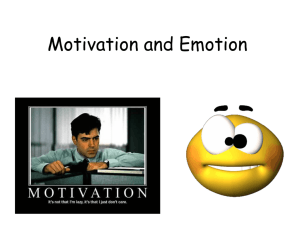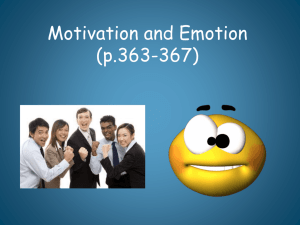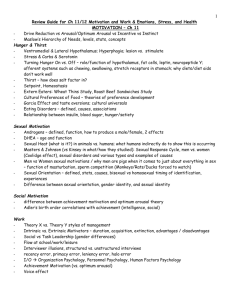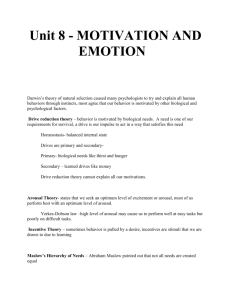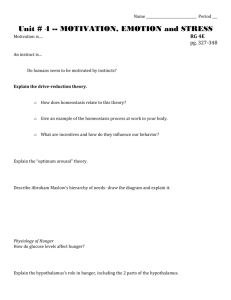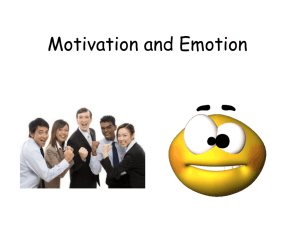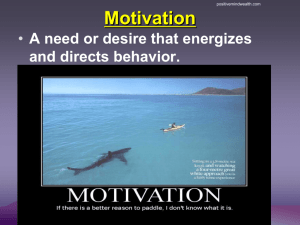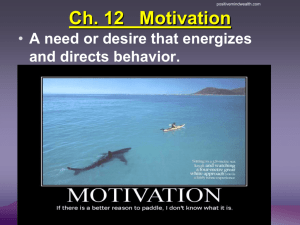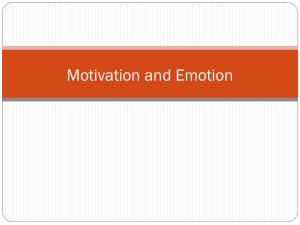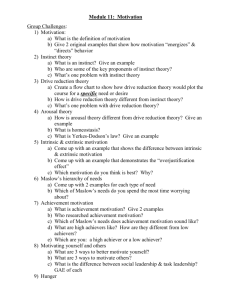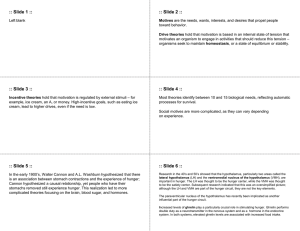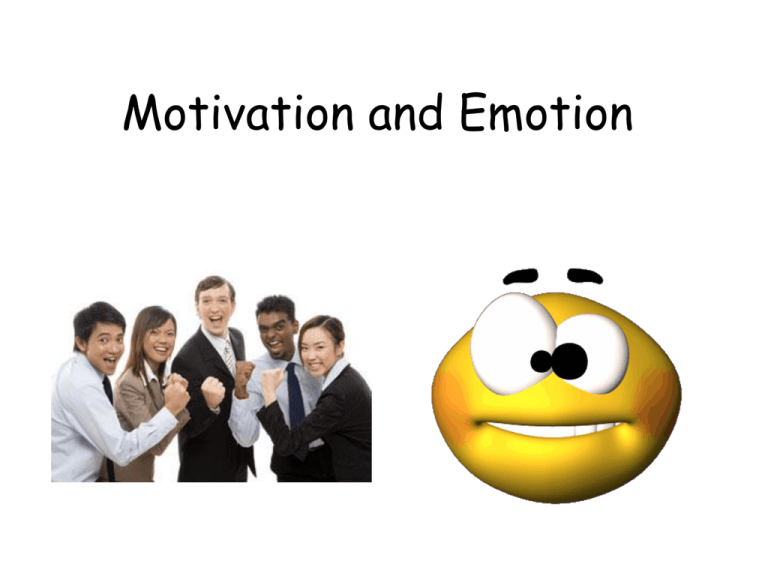
Motivation and Emotion
Motivation
• Instinct Theory: we
are motivated by our
inborn automated
behaviors.
• But instincts only
explain why we do a
small fraction of our
behaviors.
Click on the fish to watch it’s
instinctual behavior.
Drive Reduction Theory
• Our behavior is
motivated by
BIOLOGICAL NEEDS.
• Wants to maintain
homeostasis.
• When we are not, we
have a need that
creates a drive.
• Primary versus
Secondary drives
Arousal Theory
• We are
motivated to
seek an optimum
level of arousal.
• Yerkes-Dodson
Law
Maslow’s Hierarchy of Needs
• Abraham Maslow said
we are motivated by
needs, and all needs
are not created equal.
• We are driven to
satisfy the lower
level needs first.
Motivation of HUNGER
Biological Basis of Hunger
• Hunger does NOT
come from our
stomach.
It comes from our…
• Brain
What part of the
brain?
• The Hypothalamus
Hypothalamus
Lateral Hypothalamus
• When stimulated it
makes you hungry.
• When lesioned
(destroyed) you will
never be hungry again.
Ventromedial Hypothalamus
• When stimulated you
feel full.
• When lesioned you will
never feel full again.
Set Point Theory
• The hypothalamus
acts like a thermostat.
• Wants to maintain a
stable weight.
• Activate the lateral
when you diet and
activate the
ventromedial when you
start to gain weight.
• Leptin theory
Body Chemistry
• Glucose
• The hormone insulin
converts glucose to
fat.
• When glucose levels
drop- hunger
increases.
Psychological Aspects of Hunger
• Internals versus
Externals
• The Garcia Effect
Culture and Hunger
Dog
Mice Wine
Fried Frog Legs
Criadillas- bull testicles.
Eating Disorders
Bulimia Nervosa
• Characterized by
binging (eating large
amounts of food)
and purging (getting
rid of the food).
Anorexia Nervosa
• Starve themselves to below 85% of their
normal body weight.
• See themselves as fat.
• Vast majority are woman.
Click on the
woman to watch a
case study of an
anorexic.
Obesity
• Severely overweight
to the point where it
causes health issues.
• Mostly eating habits
but some people are
predisposed towards
obesity.
Click on the pictures to see
some case studies on obesity.
Sexual Motivation
• Sex is natural.
• Without sex, none of
us would be here.
• How do scientists
(or you) find out
about sex?
YOU ASK!!!!!!
Kinsey’s Studies
• Confidential interviews
with 18,000 people (in
early 1950’s).
• Sexual Behavior in the
Human Male and Sexual
Behavior in the Human
Female
• Scale of sexuality….0 to 6
where 0 is exclusively
heterosexual and 6
homosexual and 7 is
asexual.
Click on Kinsey to see the movie
trailer.
Masters and Johnson Study
• In the 1960’s William
Masters and Virginia
Johnson set out to
explore the physiology
of sex.
• 382 females and 312
males.
After their
research was
done they ran
an institute
that claimed to
turn gay people
straight.
Click on Masters and Johnson to see a more detailed explanation of
their research.
Mapped out the Sexual Response
Cycle
•
•
•
•
Initial Excitement
Plateau Phase
Orgasm
Resolution Phase
(with refractory
period).
Psychological Factors in Sexual
Motivation
• Only some people are
externals when it
comes to hunger- but
we are all externals
when it comes to sex.
• Heiman 4 tape study.
• People can find
sexually explicit
images either pleasing
or disturbing- but
they are none the less
biologically arousing.
We have discussed the energizing of sexual
motivation but have yet to discuss its direction:
Sexual Orientation
An enduring sexual attraction toward members of
either one's own gender or the other gender.
Percentage, brothers and cities
How is Sexual Orientation
Determined
• There has been NO
evidence that sexuality is
socially determined.
• Kids raised by gay
parents are no more
likely to be gay that if
they were raised by
hetero parents.
• This it is likely
biologically determined.
The Brain
• Simon LeVay
discovered that there
is a cluster of cells in
the hypothalamus that
is larger in
heterosexual men than
in heterosexual women
or homosexual men.
Prenatal Environment
• Current research
seems to point to
the hormonal levels
in the prenatal
environment.
• We have created
homosexual male fruit
flies and lesbian sheep!!!
Achievement Motivation
What motivates us to work?
(School, job, sports, video games, relationships etc..)
Intrinsic Motivators
• Rewards we get
internally, such as
enjoyment or
satisfaction.
Extrinsic Motivators
• Reward that we get for
accomplishments from
outside ourselves (grades
or money or etc..)
• Work great in the short
run.
Management Theory
Management/Teaching styles relate closely to
Intrinsic/Extrinsic Motivators.
Theory X
• Managers believes that
employees will work only if
rewarded with benefits or
threatened with punishment.
• Think employees are
Extrinsically Motivated.
• Only interested in Maslow’s
lower needs.
Theory Y
• Managers believe that
employees are internally
motivated to do good work
and policies should encourage
this internal motive.
• Interested in Maslow’s
higher needs.
When Motives Conflict
• approach-approach
conflict
• avoidance-avoidance
conflict
• approach-avoidance
conflict
• Multiple approachavoidance conflicts
Emotion
• Willam James and Carl
Lange came up with the
James-Lange Theory
of Emotion.
• We feel emotion
because of biological
changes caused by
stress.
• The body changes and
our mind recognizes the
feeling.
Cannon-Bard Theory of Emotion
• Say James-Lange theory
is full of crap.
• How can that be true if
similar physiological
changes correspond with
drastically different
emotional states.
• The physiological change
and cognitive awareness
must occur
simultaneously.
• They believed it was the
thalamus that helped
this happen.
Two-Factor Theory of Emotion
• Stanley Schachter explains emotions
more completely that the other two
theories.
• They happen at the same time but…
• People who are already
physiologically aroused experience
more intense emotions than
unaroused people when both groups
are exposed to the same stimuli.
• Biology and Cognition interact with
each other to increase the
experience.
Stress
• Social readjustment
rating scale (SRRS)
• Life Changing Units
(LCUs)- marriage,
change job, etc…
• The more LCUs you
have the higher your
score is on the SRRS.
• Those who score
higher are more likely
to have stress related
disease.
Seyle’s General Adaptation
Syndrome
• Describes our
response to a
stressful event.
• Three stages
1. Alarm
2. Resistance
3. Exhaustion

